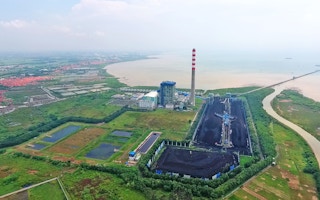Indonesia’s energy minister, Bahlil Lahadalia, announced in February that the government would be retiring Cirebon-1, a 660-megawatt (MW) coal power plant in West Java, much earlier than planned.
To continue reading, subscribe to Eco‑Business.
There's something for everyone. We offer a range of subscription plans.
- Access our stories and receive our Insights Weekly newsletter with the free EB Member plan.
- Unlock unlimited access to our content and archive with EB Circle.
- Publish your content with EB Premium.
Cirebon-1 was the first project earmarked for early retirement under the Just Energy Transition Partnership (JETP), a climate finance agreement made between wealthy nations and coal-dependent developing nations. Though doubt was cast over the viability of JETP by the withdrawal of the United States from the deal earlier this month, Indonesia could shut some plants early anyway.
Lahadalia said that Cirebon-1 would be offline by 2035 – seven years earlier than initially planned, easing financial and legal concerns that emerged from the retirement plan last September. The plan, which was devised by Asian Development Bank, Indonesia’s state power utility PLN, and PT Cirebon Electric Power, is to replace the plant with a renewable energy system consisting of solar, wind, and waste-to-energy.
According to a recent report released by Centre for Research on Energy and Clean Air (CREA), the early retirement of Cirebon-1 will prevent 6,370 deaths from its negative health impacts, and US$4.4 billion (IDR67 trillion) of economic burden from respiratory diseases and lost productivity avoided between 2036 and 2042.
“
We don’t trust any energy source outright. We want to see real examples first, that show that it’s truly environmentally friendly and benefits local communities.
Aun Anwaruddin, chairman, Rakyat Penyelamat Lingkungan
Similar benefits could also result from the second JETP pilot project. The early retirement of the 1,050-MW Pelabuhan Ratu coal power station in 2037 will prevent 5,409 deaths and US$3.7 billion (IDR 57 trillion) in economic losses between 2038 and 2043.

Particulate pollution levels from the Pelabuhan Ratu power station, which has been slated for retirement in 2037 [click to enlarge]. Source: CREA
While this marks a breakthrough for Indonesia’s energy transition, concerns over labour rights and compensation for environmental damage loom over this milestone, exposing loopholes in the plan to justly transition the country to renewable energy.
Transparency deficit
The Cirebon-1 coal power plant was built in 2007. An environmental impact assessment was conducted a year after the plant was built. Operations began in 2012.
Rakyat Penyelamat Lingkungan (RAPEL), a local environmental organisation in West Java, reported that of the 300 people employed at the power plant, only 50 are from Kanci Kulon, the local village surrounding the facility. Most of these local workers are employed as security staff and cleaners.
Those seeking employment at the plant were required to pay illegal fees ranging from IDR1m-3m (US$60-180) just to be hired. This unlawful practice has persisted for years, yet both the government and the corporation have turned a blind eye.
“The claim that coal-fired power plants bring prosperity to the surrounding community has always been a lie, I would say,” explained Aan Anwaruddin, RAPEL’s chairman.
Currently, neither the ADB nor PT Cirebon Electric Power has provided adequate public consultation on the plant’s early retirement, leaving employees uncertain about their future job prospects, according to the Indonesian Forum for the Environment’s (WALHI) West Java Chapter.
“Many workers remain anxious, with no certainty from either the government or the power plant regarding their employment status. They need clarity on the early retirement plan to prepare for the transition, whether by seeking new jobs or demanding their rights,” said Wahyudi Iwang, executive director of WALHI West Java.
This uncertainty is exacerbated by the delays in finalising the Cirebon-1 early retirement roadmap. Initially expected to be completed by September 2024, the roadmap process has stalled.
“Their roadmap is unclear. Even in our most recent letter to the ADB, we requested transparency on the plans for early retirement, but we have yet to receive a response,” stated Iwang.
According to the Center for Economic and Law Studies (CELIOS), a research group, the regional government should have already developed an action plan to diversify the local economy and provide upskilling and reskilling programmes for power plant employees. However, no action has been taken so far.
“The regional government must diversify the economy by developing sectors such as tourism, fisheries, and community plantations, as it is crucial for mine workers. Meanwhile, upskilling and reskilling programmes should be provided for employees in the electricity sector, such as PLN and maintenance staff,” explained Bhima Yudhistira, executive director of CELIOS.
Uncertainty in environmental damage compensation
Over the past 13 years, the Cirebon-1 coal power plant has had a negative impact on local fishermen in the surrounding areas, according to RAPEL.
“Before the power plant was built, people could easily earn IDR400,000 (US$24) to IDR600,000 (US$36) a day without needing diesel or boats. They only had to walk about 1.5 kilometers, and they could return home with hundreds of thousands of rupiah by catching abundant fish,” said Aan.
However, ever since the power plant was constructed, their livelihoods have been disrupted.
“Many fishing grounds have disappeared, forcing fishermen to travel much farther to find new locations, which significantly increases operational costs. Even then, their catch is often uncertain and far less abundant,” said Iwang.
Moreover, local fishermen have been forced to sail much farther, reaching the border of Central Java. Unfortunately, marine pollution from the power plant has expanded to other areas, including coastal towns and neighbouring city borders. The marine ecosystem has suffered severe damage due to coal spills and coal barges, which have devastated coral reefs and destroyed fishing nets.
On the land, salt farmers have also been impacted by the pollution, worsening the quality of the salts as it gets mixed with the dust produced by the coal chimney.
“When the plant shuts down, we hope for land rehabilitation so this 140-hectare area can be used for salt farming again, restoring local livelihoods. We also urge for an end to coal spills to revive the marine ecosystem, allowing fish and shrimp to return,” stated Aan.
There has been no further information from ADB and the power plant regarding the environmental damage compensation or rehabilitation efforts to restore the ecology, according to WALHI.
“The damage may not be fully reversible, but at least there should be clear efforts to restore it, based on the interests of the people. One of our recommendations to restore the ecology is to plant mangroves, as they are crucial for restoring areas that were previously damaged,” said Iwang.
Transition to renewable energy
With the early retirement of Cirebon-1 and Pelabuhan Ratu, at least 14,000 of workers will lose their jobs. However, according to CELIOS, this number will be outweighed by job creation in the renewable energy sector that will soon replace the coal power plants.
“The closure of the coal power plants will generate 639,000 new jobs. While some will be affected, the overall impact will be outweighed by job creation,” said Bhima.
From a fiscal perspective, reducing coal power plants can help cut electricity oversupply, which costs the state IDR21 trillion (US1.3 billion) annually, Bhima explained.
Additionally, transitioning to renewable energy could attract more investors, as many companies have recently started relocating to Vietnam. This shift is supported by Vietnam’s power wheeling system, which allows businesses to use government-owned transmission networks for renewable energy.
Despite this significant economic potential, the plan to replace the coal plant with renewable energy is widely rejected by residents of Kanci Kulon village. Many referred to the past environmental damage caused by the coal plant, leading to deep distrust among the community.
“We don’t trust any energy source outright. We want to see real examples first, whether it’s truly environmentally friendly and whether it genuinely benefits local communities,” commented Aan.
Meanwhile, activists emphasise the need to safeguard livelihoods and protect the environment during the transition to renewable energy.
“When we talk about solar panels we must also consider the battery storage, which often contains highly polluting substances. There needs to be a thorough assessment of how they will be maintained, and whether their storage will impact ecosystems,” explained Iwang.










